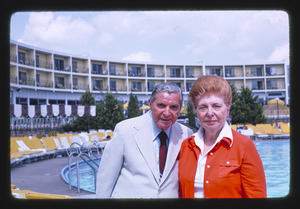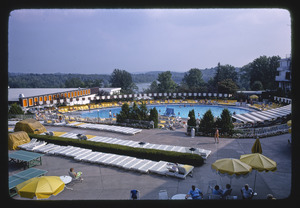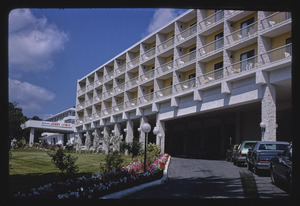Brown's Hotel (Catskills) facts for kids
Brown's Hotel was a very famous resort in the Catskill Mountains of New York State. It was one of the biggest and fanciest hotels of its kind. This was during a time when the whole area was a popular place for tourists.
From the 1940s to the 1980s, Brown's Hotel was a favorite vacation spot. Many families from the New York City area, especially Jewish-American families, loved to visit. Hotels in this area, known as the Borscht Belt, welcomed Jewish families. This was important because, at the time, some other hotels were not as welcoming. Brown's Hotel was located in a small town called Loch Sheldrake, New York, in Sullivan County, New York.
Contents
History of Brown's Hotel
By the 1940s, Sullivan County, New York became a popular vacation spot. It was in the Catskill Mountains north of New York City. Many middle and upper-class Jewish families from the Northeast came here. The area was even called the Borscht Belt or the Jewish Alps.
In 1944, Charles Brown bought the Black Apple Inn for $70,000. He already owned several hotels. The Appel family had built the inn in the early 1920s. Charles and his wife Lillian spent another $100,000 to fix it up. The hotel had 473 rooms and opened as Charles and Lillian Brown's Hotel and Country Club.
The resort became known for attracting rich guests. It competed with other big hotels nearby. Brown's Hotel didn't have a golf course. So, the owners focused on amazing food and famous entertainers to attract visitors.
Famous Guests and Shows
The hotel's Brown Derby night club hosted many big stars. Comedians like Bob Hope, Buddy Hackett, Jackie Mason, Woody Allen, and George Burns performed there. Musicians such as Sammy Davis, Jr., Tony Bennett, Harry Belafonte, and Liberace also played. Even Hollywood stars like Jayne Mansfield and boxer Jack Dempsey visited.
In the 1950s and 1960s, Brown's became one of the top three hotels in the Catskills. The others were Grossinger's and The Concord. It was a fancy place, known for being great for families. Like modern cruise lines, guests enjoyed unlimited food and entertainment. Brown's Hotel used slogans like “There’s More of Everything” and “A bit of California at your doorstep.” The hotel opened in April and closed in early November each year.
In the summer of 1954, comedian Jerry Lewis arranged for Brown's Hotel to host the first showing of his movie Living It Up. He didn't tell his co-star, Dean Martin. This caused an argument, which was one reason their famous comedy team, Martin and Lewis, broke up. The movie later premiered in Atlantic City.
Decline of the Hotel
In 1978, Charles Brown passed away. That summer, Bob Hope performed at the hotel for $50,000. Lillian Brown, who owned the hotel, started giving small parts of the company to her grandson, Bruce.
Over time, things changed for all the hotels in the Borscht Belt. The area's popularity as a resort faded. Brown's Hotel began to struggle financially.
In 1985, Brown's Hotel, along with The Pines Hotel and Kutsher's, tried something new. They started building homes for families who wanted a second house in the mountains. These families could live on the hotel grounds and use the hotel's sports and entertainment facilities for an extra fee. Fancy townhouses with high ceilings and fireplaces opened in December that year. Investors hoped to build thousands of homes in the area. Bruce Turiansky, Charles and Lillian Brown's grandson, was in charge of Brown's Hotel at this time. He felt hopeful about the plan.
However, in 1986, the hotel was still having money problems. Lillian Brown stepped down as president, and Bruce took over. This was to make investors think the company was going in a new direction. But the plan didn't work. In 1988, Lillian Brown had to file for bankruptcy. A deal to sell Brown's Hotel to the owner of another hotel fell through.
Lillian Brown died in 1997 at age 93. By this time, very few of the many hotels in the Catskills were still open. Brown's Hotel, which had grown to 570 rooms, closed for the season on November 11, 1988. It never reopened.
Eighteen days later, all the buildings and 160 acres of land were sold for $5.3 million. A real estate developer planned to keep it as a hotel. The sale helped pay off a large debt.
New Life as Condos
Renovation finally began in 1997. The resort was turned into 396 apartments called Grandview Palace condominiums. The swimming pools, tennis courts, miniature golf course, chapel, synagogue, and bar were all kept. Even the Jerry Lewis theater remained. Many people bought units, some for weekends and others to live there full-time.
Rumors and Myths about Brown's
Some people say that Brown's Hotel helped inspire "Kellerman’s Resort" in the 1987 movie Dirty Dancing. Some even wrongly claimed that parts of the movie were filmed at Brown's. The movie's writer, Eleanor Bergstein, spent summers in the Catskills as a child. The movie's dance instructor character was based on a real instructor at nearby Grossinger's Resort. The Catskills hotels influenced the movie's feel. However, most hotels in the area, including Grossinger's, had closed by the mid-1980s. So, the movie was filmed in Virginia and North Carolina.
There were also rumors that parts of the 1976 Woody Allen film The Front and the 1974 Dustin Hoffman film Lenny were filmed at Brown's. However, The Front was shot in Manhattan. And while comedian Lenny Bruce did perform at Brown's, the movie Lenny was filmed in Miami Beach. Both movies do have scenes that look a lot like Brown's Hotel.
Jerry Lewis and Brown's Hotel
A common story on the internet is that famous comedian Jerry Lewis worked as a waiter at Brown's Hotel. This is not true. Before owning Brown's, Charles and Lillian Brown ran a smaller hotel called the Hotel Arthur. Jerry Lewis worked there as an emcee (a host) and a tea boy. He even came back to perform after he became famous in Hollywood.
The Brown family also opened the Ambassador Hotel, where Jerry Lewis first performed as a comedian in 1942. So, Jerry Lewis was an entertainer, not a restaurant worker. When Charles and Lillian Brown opened Brown's Hotel in 1944, they later named their lounge The Jerry Lewis Theatre Club. This was to honor their famous friend.
Billboards along the highway encouraged drivers to “Do a Jerry Lewis - Come to Brown’s.” Jerry Lewis was a big part of their advertising. His father, Danny, who was also an entertainer, sometimes hosted shows at the lounge. For many years, during his famous telethon for muscular dystrophy, Jerry Lewis would ask viewers to call “Uncle Charles and Aunt Lillian” at Brown's Hotel to donate. Brown's Hotel was an official place where people in the Catskills could call to make donations.
The Grandview Palace Fire
In March 2012, the city of Fallsburg warned that the Grandview Palace condominiums might be shut down. This was because of many safety problems, like broken sprinklers and fire alarms. The owners promised to fix them. Because of the fire safety issues, security guards had to check the buildings every 30 minutes.
On Saturday, April 14, 2012, a guard smelled wood burning near an old boiler room. A tenant also smelled smoke later but didn't think it was serious. Around 6:00 p.m., the guard found heavy smoke and flames coming from the boiler room. The first call to the fire department came at 6:06 p.m. However, the local fire chiefs were out of town.
The fire grew very large, with flames 20 to 30 feet high. It brought in over 43 fire departments and 300 firefighters. It is believed to be the biggest fire in Catskills history. Even forest rangers helped fight fires that spread into the nearby pine forests. The fire destroyed seven of the nine buildings. It spread quickly because of connecting hallways and exploding propane tanks. Over 100 residents had to leave their homes, but no one was seriously hurt. Four firefighters had minor injuries. The fire was finally put out by Sunday morning.
Officials later confirmed that the fire started in the main building, which completely collapsed. It began in a boiler room that was no longer used. The damage was so bad that investigators couldn't find one specific cause.
Insurance and Legal Issues
In July 2011, Grandview Palace got fire insurance from Hartford Insurance Company. But Hartford dropped the coverage less than two months later because of fire safety problems. Another company, Illinois Union Insurance, then provided a policy.
Several abandoned resorts in the area had burned down under suspicious circumstances before this fire. This included the former Heiden Hotel in 2008 and the Tamarack Lodge just one week before the Grandview Palace fire. In fact, over 100 hotels in the area had been destroyed by fire since the 1940s.
Many former residents of Grandview Palace came to a town meeting to ask questions. The meeting had to be moved to a bigger community center. The town board voted to condemn the entire property. This meant the two remaining buildings were not safe to live in. Only one building and part of another were structurally safe. Some parts of the building were found to have asbestos, a dangerous material no longer used in construction. The condo board was given 60 days to tear down the structure.
Grandview Palace had two insurance policies worth $30 million. But the insurance companies refused to pay. They claimed that Grandview Palace had lied about not having code violations or broken sprinklers. This led to a court case in December 2012.
Later meetings offered no new answers. Other insurance companies also refused to pay claims. The legal battles continued for the Grandview Palace.
|






